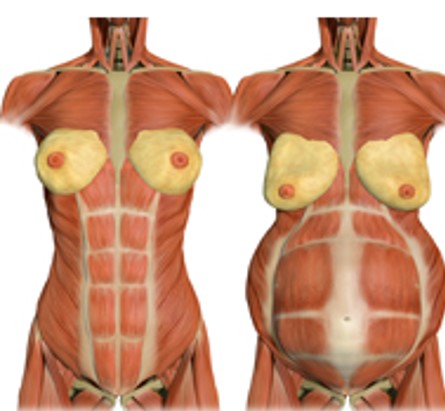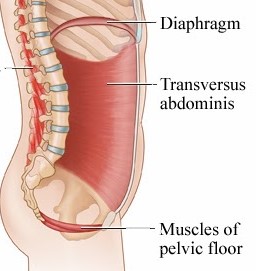Many people wonder if they should do any core work at all during the third trimester of pregnancy given the significant amount of stress already placed on the core. While there are certainly core exercises to avoid, deep core training is not only safe but highly beneficial. It helps you mitigate pains and injuries, prepare for birth, and recover faster afterward. In this post, we’ll cover the key focus of core training during the third trimester and what muscles to focus on. Then, we’ll share 8 beneficial exercises to focus on, and the ones to avoid.
Focus of Third Trimester Core Training
The primary goals of third trimester core training are to:
- Strengthen the muscles that help resist the stresses of weight gain and alignment shifts (to mitigate pains & injuries)
- Prepare the body for Stage 1 and 2 Labor
- Minimize excess intra-abdominal pressure (IAP) to mitigate Diastasis Recti and Pelvic Floor Issues
What exactly does that last point mean? Simply put, a growing baby (and belly) creates a buildup of pressure in the abdominal cavity, or intra-abdominal pressure (IAP). When there is too much pressure, it can lead to Diastasis Recti (DR) — a separation of the abdominal muscles — and Pelvic Floor Dysfunction (PFD). As you can see in the image below, a certain amount of DR is a normal and natural part of pregnancy — necessary to allow baby room to grow. However, engaging in activities or behaviors that elevate IAP beyond that caused by the growing baby can create greater pelvic floor and DR issues in the postpartum period.

Key Muscles to Focus On
The important core muscles to focus on (throughout pregnancy, including the third trimester) are the Core Canister muscles. These are the deep core muscles that form the shape of a canister: the diaphragm at the top, the pelvic floor muscles at the bottom, and the transverse abdominis wrapping all the way around the sides.

Optimally functioning core canister muscles help to stabilize the spine and pelvis (mitigating pains & injuries), facilitate a more efficient childbirth, and regulate pressure within the core. So, focusing on these muscles will accomplish all three goals listed above.
8 Beneficial Core Exercises
1. 360° Breathing: We call this the #1 most effective core exercise because it activates all your Core Canister muscles and gets them working together in harmony. The goal is to make 360° Breathing your natural style of breathing, and incorporate it into your movements throughout the day. This style of breathing is especially important in helping you stay calm and focused while managing through contractions during Stage 1 labor.
2. PFAs-Slow and Fast: Pelvic Floor Activations (PFAs) target the “floor of your core” or pelvic floor. The video below takes you on a step-by-step process to first find your pelvic floor muscles (your pee-stopping muscles are only the front), then activate them properly. Once you get the general idea of these, it’s best to then move onto pushing prep (#3 below), which becomes a bigger priority during the third trimester.
3. Pushing Practice: Once you get the hang of PFAs, transition to Pushing Prep to begin to prepare the pelvic floor muscles for how they have to respond during Stage 2 Labor.
4. Bridges: This exercise targets your glutes to help mitigate low back and other pregnancy pains. Even though you are on your back for this movement, you’re moving, so it is safe to do throughout pregnancy. Just note in the video how to transition into and out of this position, by rolling to your side first. This helps to protect your core.
5. Bird Dog: This is a highly beneficial core move that targets all your core canister muscles. If you find the full version too challenging for the third trimester (watch for that “torpedo-like” coning we discuss below), then regress the move by keeping your hands on the floor and just focusing on your legs. To take it down further, keep your legs on the floor and just lift your arms.
6. Single-Sided Carries: This is one of our favorite core moves. It is “anti-lateral flexion,” meaning it forces you to use your deep core muscles to resist being pulled sideways by the weight of the object you are holding. Not only does this strengthen your core, but it also helps you prepare your body to resist the core-compromising positions that everyday single-sided carrying (of babies, diaper bags, car seats and more) can lead to.
7. Side lift and lower plank: This regression on a side plank is another good “anti-lateral flexion” movement that helps strengthen the deep core and obliques, but in a safer way that does not elevate IAP as much as a full side plank.
8. Pallof Press: This move is “anti-rotation,” forcing you to use your deep core muscles to resist being pulled into rotation. There are several variations on this. You can also perform it tall kneeling, half kneeling, or staggered stance.
For information on core exercises to avoid in your third trimester, check out our Moves to Avoid by Trimester Guide.
Want Additional Resources?
For additional resources to help you exercise safely and effectively during pregnancy, explore our training programs and services. You’ll find a variety of offerings tailored to different needs — from education, to self-guided programs, to the ability to work with an expert coach.
Or, if you’re a health & fitness pro interested in coaching pre & postnatal clients, check out our ProNatal Education & Certification.
